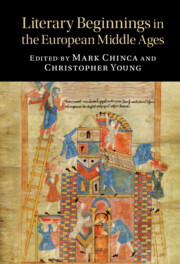Book contents
- Literary Beginnings in the European Middle Ages
- Cambridge Studies in Medieval Literature
- Literary Beginnings in the European Middle Ages
- Copyright page
- Contents
- Contributors
- Acknowledgments
- Foreword
- Chapter 1 Introduction
- Chapter 2 Scandinavia
- Chapter 3 Irish and Welsh
- Chapter 4 English
- Chapter 5 Spain
- Chapter 6 French
- Chapter 7 Dutch
- Chapter 8 Occitan
- Chapter 9 German
- Chapter 10 Italian
- Chapter 11 Czech and Croatian
- Chapter 12 Greek
- Chapter 13 East Slavonic
- Afterword
- Index
- Cambridge Studies in Medieval Literature
Chapter 4 - English
Published online by Cambridge University Press: 11 August 2022
- Literary Beginnings in the European Middle Ages
- Cambridge Studies in Medieval Literature
- Literary Beginnings in the European Middle Ages
- Copyright page
- Contents
- Contributors
- Acknowledgments
- Foreword
- Chapter 1 Introduction
- Chapter 2 Scandinavia
- Chapter 3 Irish and Welsh
- Chapter 4 English
- Chapter 5 Spain
- Chapter 6 French
- Chapter 7 Dutch
- Chapter 8 Occitan
- Chapter 9 German
- Chapter 10 Italian
- Chapter 11 Czech and Croatian
- Chapter 12 Greek
- Chapter 13 East Slavonic
- Afterword
- Index
- Cambridge Studies in Medieval Literature
Summary
Vernacular literature in English first developed in two separate iterations: the first ‘Old English’, the language brought to the island by Germanic invaders in the fifth century, and used (alongside Latin) in writing from as early as the seventh century; the second, after the hiatus brought about by the Norman Conquest, the twelfth-century re-emergence of ‘Early Middle English’, a non-standardized rendering of a fast-changing vernacular, dialectally highly variant, in constant textual contact with Latin and French. This chapter discusses each in turn, arguing that Old English literature, for all its astonishing precocity, variety, and brilliance, provides us with a fascinating study of a centuries-long, and eventually truncated, ‘beginning’: a vernacular literature sustained over time by a particular, and crucially coterminous, audience and patronage context (the royal or aristocratic court; the monastery) without ever reaching the point of being self-sustaining. In contrast, Early Middle English emerged spontaneously in the margins of multilingual manuscripts, and as an act of translation and adaptation without institutional support or aristocratic patronage; but it emerged into a different world, in which growing community literacy gave it an audience – potentially the whole population – that would drive its development ever forward.
Keywords
- Type
- Chapter
- Information
- Literary Beginnings in the European Middle Ages , pp. 69 - 89Publisher: Cambridge University PressPrint publication year: 2022
- 1
- Cited by

